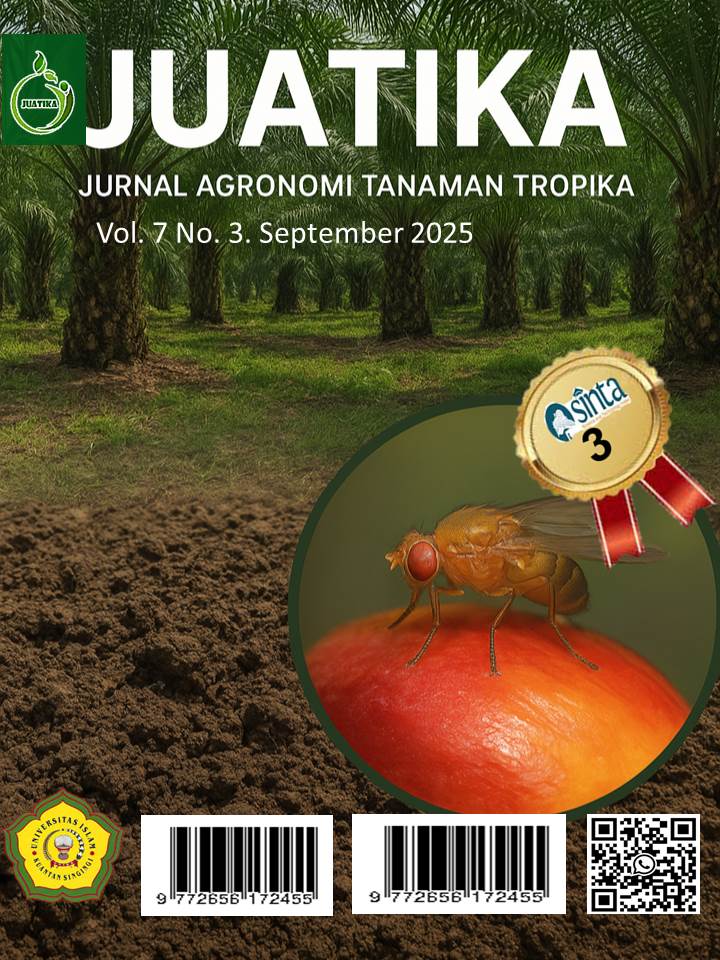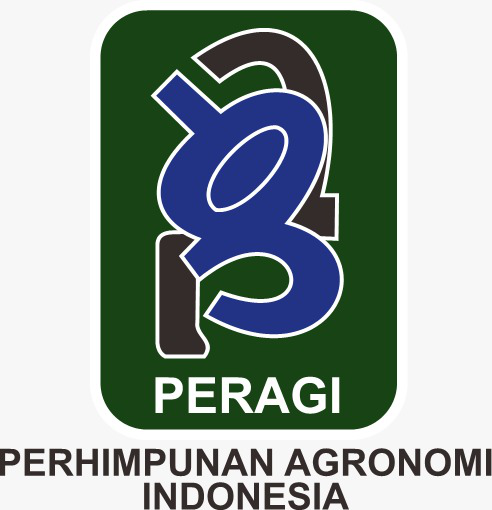Optimizing Rice Plants (Oryza sativa L.) Growth and Yield in Various Planting Systems by Providing Paclobutrazol Concentration
Abstract
Rice (Oryza sativa L.) is the primary staple food crop and a strategic source of carbohydrates for the Indonesian population. In recent years, rice production has declined at both national and local levels due to climate change, land limitations, and pest disturbances. This condition highlights the urgent need for research to develop more efficient and sustainable rice cultivation strategies. This study aimed to determine the interactive effects of planting systems and Paclobutrazol concentrations on the growth and yield of the rice variety Inpari 32. The research was conducted in Ngraho District, Bojonegoro Regency, East Java, using a Split Plot Design with two factors: planting systems (Tegel/traditional, SRI, Legowo 2:1, and modified Legowo) and Paclobutrazol concentrations (0, 600, 700, and 800 ppm). Observed parameters included plant growth and yield components. The results revealed significant interactions between planting systems and Paclobutrazol concentrations on several parameters, including the number of panicles, panicle length, and grain weight per cluster. The best results were obtained with the modified Legowo system combined with 600 ppm Paclobutrazol, which produced yields exceeding 6 tons per hectare. This combination is recommended as an effective cultivation strategy to enhance rice productivity and support sustainable national food security.
Downloads
References
Desta, B., & Amare, G. (2021). Paclobutrazol as a plant growth regulator. Chemical and Biological Technologies in Agriculture, 8(1), 1–15.
Ezward, C., Suliansyah, I., Rozen, N., & Dwipa, I. (2022). Resistance of local rice genotypes against brown planthopper pest in Kuantan Singingi Regency. Jurnal Agronomi Tanaman Tropika (Juatika), 4(1), 166–176.
Fauziah, I., Sulistyono, A., & Suhardjono, H. (2024). Pengaruh konsetrasi paclobutrazol dan model tanam terhadap pertumbuhan dan hasil tanaman padi (Oryza sativa L.) varietas Inpari-42. Plumula: Berkala Ilmiah Agroteknologi, 12(1), 33–44.
Adnyana, I. N. S. (2020). Efektifitas sistem tanam jajar legowo 2:1 dengan sistem tegel terhadap produktivitas padi sawah di Subak Babakan Cangi, Desa Batuan Kaler, Kecamatan Sukawati, Kabupaten Gianyar. DwijenAGRO, 10(2), 127–133.
Jayanti, A. S., Sulistyono, A., & Utomo Pribadi, D. (2022). The effect of paclobutrazol concentration and types of organic liquid fertilizer on the growth and production of tomato (Solanum lycopersicum L.). Jurnal Agronomi Tanaman Tropika (Juatika), 4(1), 48–60.
Lutfiana, N., Jumadi, R., & Lailiyah, W. N. (2023). Uji dosis paclobutrazol terhadap pertumbuhan dan hasil tiga varietas padi (Oryza sativa L.) di Kabupaten Nganjuk. Tropicrops (Indonesian Journal of Tropical Crops), 6(2), 113.
Martina, I., & Pebriandi, A. (2020). Pengaruh jarak tanam pada sistem tanam jajar legowo terhadap produktivitas padi varietas Inpari 32. Agrifor, 19(2), 257.
Maulidi, W., Warganda, Darussalam, & Pangestu, A. R. (2024). Pengaruh konsentrasi paclobutrazol pada berbagai sistem tanam terhadap pertumbuhan dan hasil jagung manis pada tanah gambut di Desa Rasau Jaya 2. Jurnal Pertanian Agros, 26(1), 4544–4552.
Ningrat, M. A., Mual, C. D., & Makabori, Y. Y. (2021). Pertumbuhan dan hasil tanaman padi (Oryza sativa L.) pada berbagai sistem tanam di Kampung Desay, Distrik Prafi, Kabupaten Manokwari. Prosiding Seminar Nasional Pembangunan dan Pendidikan Vokasi Pertanian, 2(1), 325–332.
Dinas Ketahanan Pangan dan Pertanian. (2023). Data produksi pertanian. https://data.bojonegorokab.go.id/dinas-ketahanan-pangan.html
Prihantari, E. T., Hardiyati, T., & Samiyarsih, S. (2022). Kualitas biji dan karakter agronomi padi hitam (Oryza sativa L.) lokal Pekalongan dengan penambahan paklobutrazol dan giberelin. BioEksakta: Jurnal Ilmiah Biologi Unsoed, 3(2), 88–95.
Rombon, D., Najoan, J., & Runtunuwu, S. D. (2019). Pengaruh interaksi konsentrasi dan waktu aplikasi paclobutrazol terhadap pertumbuhan dan hasil tanaman padi sawah (Oryza sativa L.) varietas Serayu. Jurnal Ilmiah Fakultas Pertanian Universitas Sam Ratulangi, 1(3), 3–5.
Silitonga, R. S., & Nasution, J. (2019). Interaksi kotoran ayam dan paclobutrazol terhadap jumlah anakan padi hitam (Oryza sativa L.) di Kecamatan Batang Angkola-Tapanuli Selatan. Jurnal LPPM UGN, 10(1), 1–5.
Badan Pusat Statistik. (2023). Luas panen dan produksi padi di Indonesia 2023 (angka sementara). Jurnal Penataan Ruang.
Suharno, & Isnayanti, F. (2018). Pengaruh populasi bibit sistem tanam tegel penanaman musim tanam II terhadap pertumbuhan dan produktivitas padi (Oryza sativa L.). Jurnal RISET Agribisnis & Peternakan, 3(1), 35–50.
Tambajong, C. M., Lengkong, E., & Runtunuwu, D. S. (2016). Pengaruh interaksi paclobutrazol dan tipe tanam jajar legowo pada produksi padi metode tanam SRI. Agri-SosioEkonomi Unsrat, 12, 127–134.
Copyright (c) 2025 Maya Novita, Agus Sulistyono, Ida Retno Moeljani

This work is licensed under a Creative Commons Attribution 4.0 International License.
Authors who publish with Jurnal Agronomi Tanaman Tropika (JUATIKA) agree to the following terms:
Authors retain copyright and grant the Jurnal Agronomi Tanaman Tropika (JUATIKA) right of first publication with the work simultaneously licensed under a Creative Commons Attribution License (CC BY 4.0) that allows others to share (copy and redistribute the material in any medium or format) and adapt (remix, transform, and build upon the material for any purpose, even commercially) with an acknowledgment of the work's authorship and initial publication in Jurnal Agronomi Tanaman Tropika (JUATIKA).
Authors are able to enter into separate, additional contractual arrangements for the non-exclusive distribution of the journal's published version of the work (e.g., post it to an institutional repository or publish it in a book), with an acknowledgment of its initial publication in Jurnal Agronomi Tanaman Tropika (JUATIKA). Authors are permitted and encouraged to post their work online (e.g., in institutional repositories or on their website) prior to and during the submission process, as it can lead to productive exchanges, as well as earlier and greater citation of published work.







 More Information
More Information



